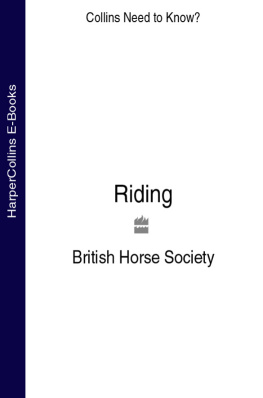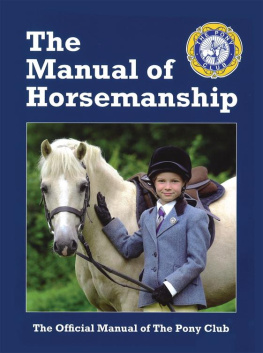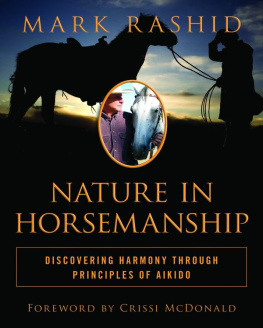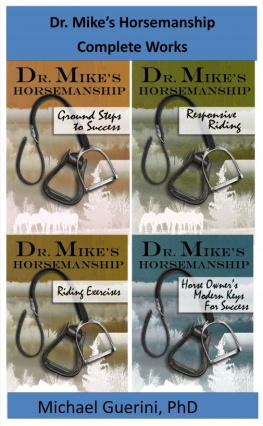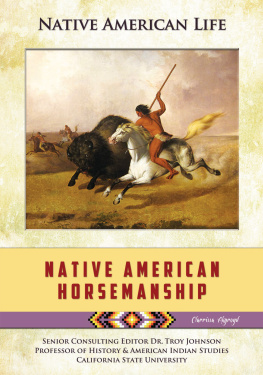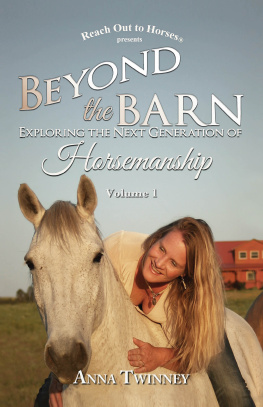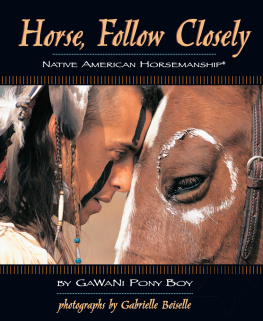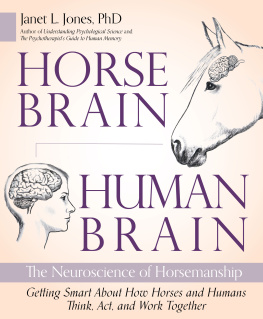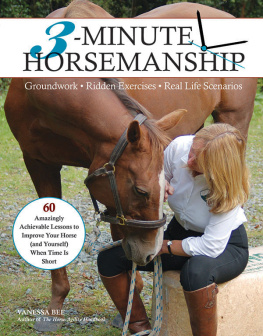British Horse Society - BHS Complete Horsemanship Volume One
Here you can read online British Horse Society - BHS Complete Horsemanship Volume One full text of the book (entire story) in english for free. Download pdf and epub, get meaning, cover and reviews about this ebook. City: La Vergne, year: 2017, publisher: Quiller, genre: Home and family. Description of the work, (preface) as well as reviews are available. Best literature library LitArk.com created for fans of good reading and offers a wide selection of genres:
Romance novel
Science fiction
Adventure
Detective
Science
History
Home and family
Prose
Art
Politics
Computer
Non-fiction
Religion
Business
Children
Humor
Choose a favorite category and find really read worthwhile books. Enjoy immersion in the world of imagination, feel the emotions of the characters or learn something new for yourself, make an fascinating discovery.
- Book:BHS Complete Horsemanship Volume One
- Author:
- Publisher:Quiller
- Genre:
- Year:2017
- City:La Vergne
- Rating:3 / 5
- Favourites:Add to favourites
- Your mark:
- 60
- 1
- 2
- 3
- 4
- 5
BHS Complete Horsemanship Volume One: summary, description and annotation
We offer to read an annotation, description, summary or preface (depends on what the author of the book "BHS Complete Horsemanship Volume One" wrote himself). If you haven't found the necessary information about the book — write in the comments, we will try to find it.
BHS Complete Horsemanship Volume One — read online for free the complete book (whole text) full work
Below is the text of the book, divided by pages. System saving the place of the last page read, allows you to conveniently read the book "BHS Complete Horsemanship Volume One" online for free, without having to search again every time where you left off. Put a bookmark, and you can go to the page where you finished reading at any time.
Font size:
Interval:
Bookmark:
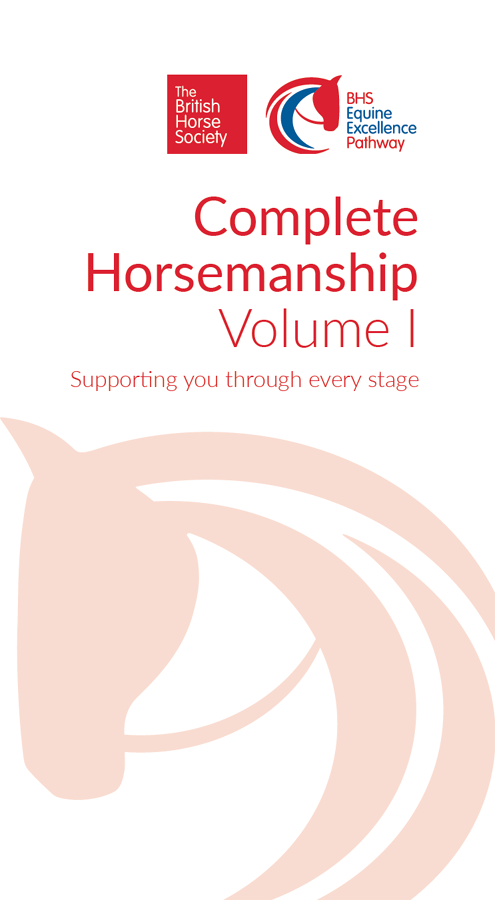

The British Horse Society would like to thank all those who have been involved in the development and production of Complete Horsemanship Volume I including Berkshire Riding Centre, Home Farm Hothorpe, Millfield School, Warwickshire College, Wellington Riding Centre, The BHS Quality and Training Committee, Cardboard Bedding Solutions Ltd, Jon Stroud Media, Sorbeo Horse Bedding, Tara Taylor Photography, Lucy Higginson and Sabrina Jones FBHS.
Welcome to the Complete Horsemanship series from the British Horse Society (BHS). If you are passionate about horses and want to learn more about how to care for them and improve your riding skills, this first volume is for you.
In it you will find chapters on how to:
Understand why horses behave the way they do and how to handle their behaviour.
Feed, groom, and generally look after horses.
Recognise what to look for on a day-to-day basis and know who to tell if you think a particular horse is unwell or behaving differently.
Describe and talk about the physical make-up of horses.
Understand what horses need on a daily basis.
Tack up and provide rugs for horses doing different types of work.
Most of all, it will help you have fun developing your riding and horse management skills, whether you want to enjoy this wonderful sport recreationally, or youre thinking about pursuing a career with horses.
If you are thinking of a career in the equestrian world whether as a groom, equine dentist or physiotherapist, or even if you aspire to riding in the Olympics, you will need to develop the skills that will make you stand out to employers.
The BHS education system is one of the best and most widely-respected in the world. The Complete Horsemanship series supports anyone wishing to study qualifications within the BHS Equine Excellence Pathway. There are a number of bespoke professional career pathways available, depending on your long-term goal. Whether its becoming a successful groom or a stable manager, an equine teacher or a specialist coach, theres a pathway to choose from.
Equestrian qualifications show potential employers the skills accrued for a career with horses. The BHS qualifications framework is internationally recognised, with some of the best instructors, riders and grooms coming through the BHS Equine Excellence Pathway, including Fellows Carl Hester and Yogi Breisner. The BHS Equine Excellence Pathway gives each student the opportunity to gain qualifications and awards in their chosen profession. They have been specially developed through extensive consultation with the equine industry to incorporate the latest research and thinking, with current practices and friendly assessment methods.
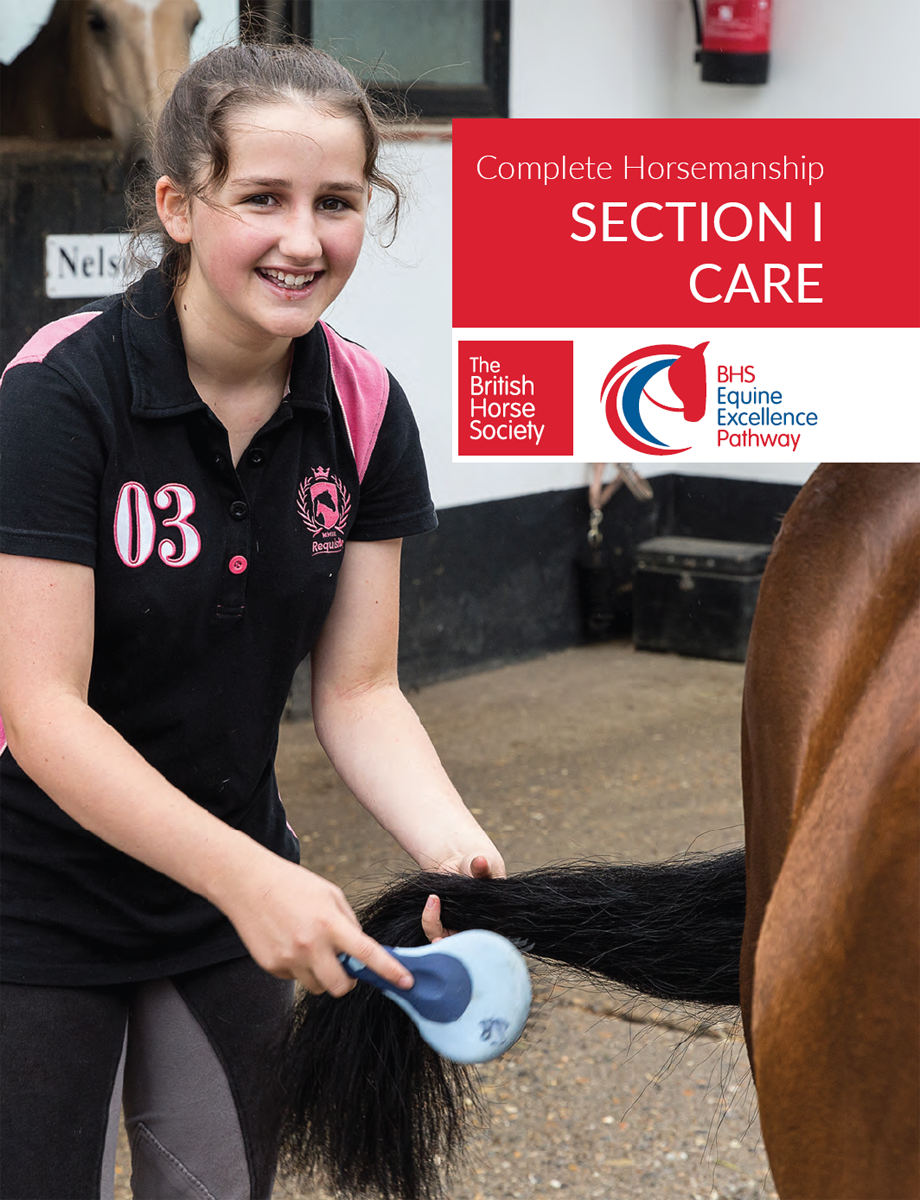

If we are to understand why horses behave the way they do, we first need to learn the behaviour of wild horses and how domestication has led them to adapt to a changed environment. Horses have been domesticated for around 6,000 years and their interaction with humans has given them the benefits of regular food, water, treatment of disease and injury and protection from predators. However, with domestication comes behavioural changes a domesticated environment can be very unnatural. A wild horse is able to choose his herd mates, may browse for his own food and water and is free to choose how and when he socialises, exercises and rests.
A domesticated horse is often stabled, restricting in his freedom to move, browse for food or water, or socialise and interact with other horses.
Horses have evolved over millions of years to browse and eat for 1416 hours per day and can travel huge distances in the wild in search of food and water. They are also prey animals and have depended on their flight or fight instinct for survival. When frightened, they will usually run away, but if this isnt an option they may fight.
Although horses in our care face far fewer threats, their flight or fight instincts still lead them to run first and think later; they may often spook at things that humans are unable to see, hear or smell.
Horses are very social, herd-orientated animals and are very good at communicating, cooperating and looking after one another. They form close relationships with one another and often create friendships called pair bonds, which can last a lifetime. These relationships help keep them safe from predators, as herd members can keep an eye out for one another and raise the alarm if they see a threat. Even in a domesticated herd you will rarely see all the horses lying down together; instead herd members take turns to rest while another horse stands over them as a lookout.
Many of us have experienced a horse who calls and paces the fence line when left in the field on his own, or one who refuses to load, naps when leaving the yard on his own, or doesnt seem to be able to concentrate during a dressage test.
Some horses suffer from separation anxiety, becoming very stressed when away from other horses, and must be gradually re-educated to feel safe when alone. The same is true for horses who barge out of the stable in the morning in anticipation of being led to the field, or become excited and jog on the way there. Escaping the confines of the stable for the exercise, social interaction and grazing available in the field can be very exciting.

Horses in a herd.
You may have heard people talk about alpha mares or stallions, by which we refer to horses who appear to be in charge of the others and will fight off those who stand in their way.
Different horses lead the herd in different situations one particular horse or pair may lead it in search of better grazing, for example but you may see a different horse taking charge of a pile of hay and yet another one seeing off a predator to protect the herd.
To create a peaceful and safe herd, it is important to establish social structure; however, this structure is very complex. Many people believe it is constant and based on dominance, which is not always the case. Although you may see a horse being aggressive towards another in a domesticated environment, this is because resources such as food, water and space are limited and the horse exerts aggression to secure enough to eat. For example, you may see one horse fighting off the others when hay is put in the field. However, such behaviour may be far less common in the wild if resources are plentiful. Similarly, you may see a domesticated horse show territorial aggression to a field mate who comes too close, but compare the space a horse has in the wild to that available in a small man-made paddock. The domesticated horse is simply using his survival instinct to ensure he has enough food and space. You will often see that horses grazing together will establish a pecking order, on the basis of who is the most dominant animal.
Next pageFont size:
Interval:
Bookmark:
Similar books «BHS Complete Horsemanship Volume One»
Look at similar books to BHS Complete Horsemanship Volume One. We have selected literature similar in name and meaning in the hope of providing readers with more options to find new, interesting, not yet read works.
Discussion, reviews of the book BHS Complete Horsemanship Volume One and just readers' own opinions. Leave your comments, write what you think about the work, its meaning or the main characters. Specify what exactly you liked and what you didn't like, and why you think so.


